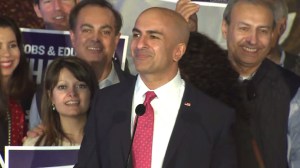Though there were few attention-grabbing statewide races or ballot measures, Californians headed to the polls Tuesday to cast their votes in the 2014 midterm, re-electing Gov. Jerry Brown to an unprecedented fourth term.
Polls closed at 8 p.m. and results trickled in over the course of the evening, but the gubernatorial election was called in favor of Brown almost immediately by the Associated Press.
LIVE ELECTION RESULTS: California election returns data here
Turnout was predicted to be low in the state, which had few of the galvanizing races or the kinds of divisive issues on the ballot that were at stake elsewhere in the country, where Republicans earned enough seats to take control of the U.S. Senate for the first time since 2006.
Nonetheless, a slew of statewide offices were set to be determined. More than 17.8 million Californians were registered to vote in the election, according to the Secretary of State’s office.
Brown had been expected to easily win over Republican challenger Neel Kashkari, a former investment banker who oversaw the federal government’s bank bailout under for the Bush and Obama administrations. Lt. Gov. Gavin Newsom won a second term, and all the other top statewide offices were before voters too.

Kashkari congratulated the governor in his concession speech from Costa Mesa, challenging Brown to “be bold” in his next term. In a statement, Kashkari said his campaign had “laid the groundwork for a Republican comeback in California.”
Minutes later, speaking outside the governor’s mansion in California, Brown called his fourth term a “gift.” He said the state was going in a “progressive” but “fiscally responsible” direction.
“I’m going to do my utmost to live up to the promise of California that brought my great-grandfather … here to Sacramento in 1852,” Brown said.
Brown had 57 percent of votes with about a quarter of precincts reporting; Kashkari had 43 percent.
Most of the statewide races have proved less than thrilling, with an exception from an unexpected item on the ballot: the nonpartisan race for superintendent of public instruction. Union-backed Tom Torlakson, a former legislator and teacher, was seeking a second term, while charter schools advocate and reformer Marshall Tuck was looking for an upset.
The two were in a toss-up, an October poll showed. The costly contest has drawn attention from educators nationwide.
With about 30 percent of precincts reporting, Torlakson was ahead with 54.1 percent of the vote.
Statewide, all 80 Assembly seats were before voters, as were 20 state Senate seats and all 53 of California’s seats in the U.S. House of Representatives.
In Southern California, local contests were before voters as well.
- Los Angeles County results
- Orange County results
- Riverside County results
- San Bernardino County results
- Ventura County results
Several congressional races had drawn attention: state Sen. Ted Lieu’s effort to take over retiring Rep. Henry Waxman’s seat, based in Los Angeles’ Westside. He was facing Republican Elan Carr, a gang prosecutor who was the surprise winner of the crowded June primary field.
Lieu was leading in early returns, with 53.3 percent of the vote to Carr’s 46.8 percent.
Ventura County Democrat Rep. Julia Brownley was seeking to hold on to her seat, with a challenge from Republican Jeff Gorell.
Two Inland Empire contests were close as well. Republic Paul Chabot was facing off with Redlands Mayor Pete Aguilar, a Democrat, for the seat of retiring Republican Rep. Gary Miller in San Bernardino County.
And in Riverside County, Democrat Rep. Raul Ruiz, an emergency room doctor, was hoping for a second term. He was fending off a challenge from Republican Brian Nestande, the former chief of staff to Mary Bono Mack, whom Ruiz defeated in 2012.
Two ballot measures the governor backed were also before voters: Proposition 1, a $7.5 billion water bond; and Proposition 2, a “rainy day” fund for the state budget.
Both propositions looked strong in early returns, and the AP called the race for passage of Prop 1 just before 9 p.m. At that time, the proposition had 68.2 percent of the vote.
Proposition 2 also passed, according to Los Angeles Times projections. It had about 71 percent of the vote by 9:15 p.m.
Also on the ballot were four other measures, with some analysts predicting only Proposition 47 had a strong chance of passing. It would reduce some drug and property crimes from felonies to misdemeanors.
The Los Angeles Times called the contest in favor of Prop 47 passing. It had 70.7 percent of vote with about a quarter of precincts reporting.
Proposition 48 asked voters to ratify a compact that would allow a Northern California Indian tribe to build a casino off its reservation. The measure was backed by other casino-owning tribes that do not want to see such projects approved. It failed, the Times reported. About 59.3 percent of voters rejected the measure, according to results available when 42.2 percent of precincts were reporting.
Proposition 45 would allow the state insurance commissioner to reject health insurers’ rate changes for some types of coverage. With a quarter of precincts reporting, the measure had failed with 60.5 percent of voters rejecting it, the Los Angeles Times reported.
Proposition 46 combined several health care-related issues, raising compensation caps in medical negligence lawsuits and requiring drug testing for doctors. It failed, the Los Angeles Times reported, with 68.1 percent of voters rejecting the measure in early returns.
In the last 30 years, turnout among registered voters for nonpresidential general elections in California has ranged from about 50 to 60 percent, state records show.






